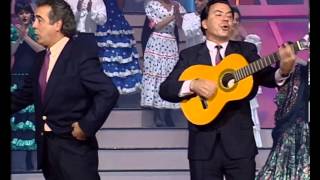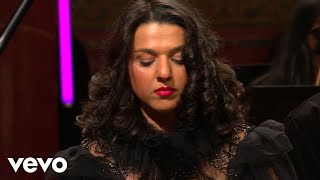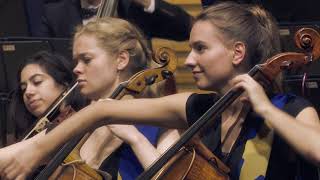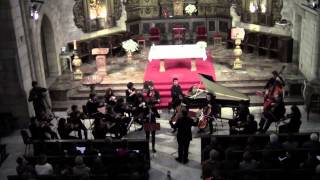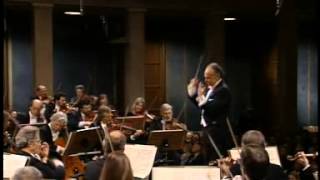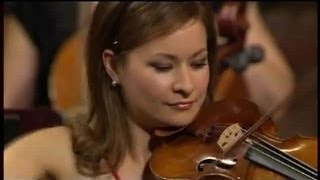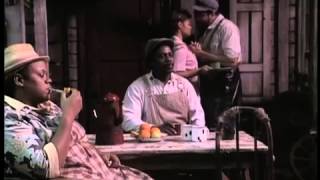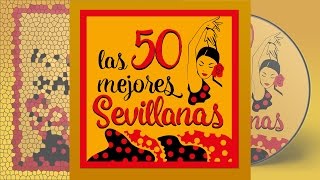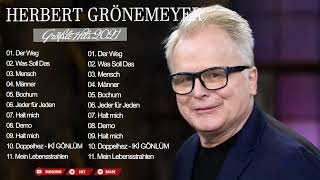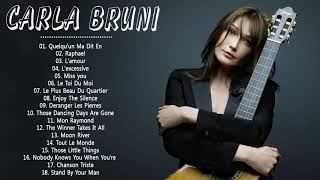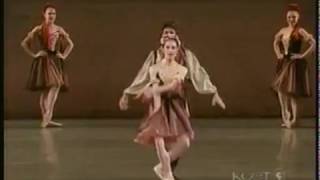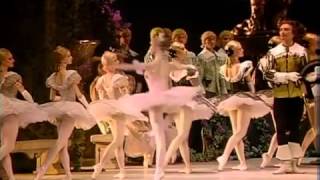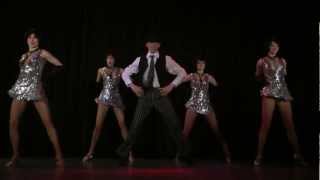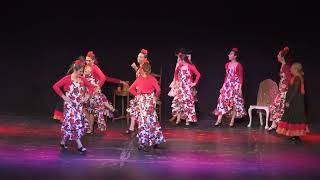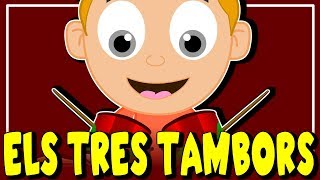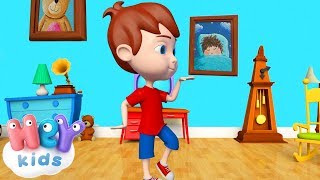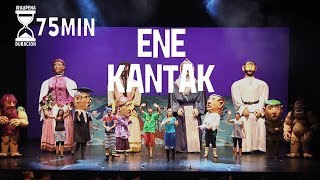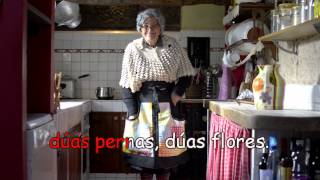This year the April Fair is being held from May 6th to 11th.
Brahms was born on May 7, 1833.
On May 7, 1893, Tchaikovsky was born.
May 9 is Europe Day.
Recommended music videos for initiation to classical music
On the night of May 5th, the “April Fair” (or Seville Fair) begins with the “pescaíto dinner” .
The April Fair or Seville Fair is a spring festival held annually in the city of Seville , where the public gathers in a large area called the Real de la Feria , with streets with temporary booths, decorated with lanterns, through which riders and horse-drawn carriages circulate and through which about 500,000 visitors pass daily. It is celebrated one or two weeks after Easter and coincides with the bullfights in the Plaza de la Maestranza . It has a great economic and social impact on the city and has been declared a Festival of International Tourist Interest .
Its origins date back to August 25, 1846, when two councilors, Narciso Bonaplata (Catalan) and José María de Ybarra (Basque), businessmen settled in the city, drafted a proposal that they took to the City Council requesting the holding of an agricultural and livestock fair.
Los del Río are a Spanish musical group made up of Antonio Romero Monge (1948) and Rafael Ruiz Perdigones (1947), residents of the Sevillian town of Dos Hermanas . They joined together in 1962, when they were fourteen years old, to participate in the program " Ronda del Domingo " (Radio Sevilla, Cadena SER) and in 1965 they appeared for the first time on national television, debuting in Madrid in the most popular flamenco tablaos of the time. Their greatest success would come in 1993 when they composed Macarena; the song became a social phenomenon that would end up crossing borders and generations, breaking all imaginable records.
Today Los del Río offer us the song "Seville has a special color," composed by the Andalusian singer and composer Romero San Juan (San Juan de Aznalfarache 1948-2005).
Johannes Brahms (1833-1897) born in Vienna , where he spent most of his life, was the most conservative composer of the Romantic movement compared to the progressive movement led by Liszt and Wagner . His music is firmly rooted in the structures and composition techniques of the classical masters and its formal structures faithfully follow the patterns of Classicism , although it uses some of the color of Romanticism and popular music . Of an eminently perfectionist character, he wrote for piano, chamber ensembles, symphony orchestra, for solo voices and for choir. It was Hans von Bulow who proposed the "three B's" referring to Bach , Beethoven and Brahms as the three main pillars of the History of music.
Catalogue of Brahms's works . His works are classified by their Opus number (from the Latin opus 'work'; op. abbreviation), which is a term used in music to catalogue the works of most composers since the 17th century .
Akademische Festouvertüre , Op. 80 (Academic Festival Overture) is a concert overture by Johannes Brahms , and dates, like his other overture, the Tragic Overture , from 1880; it was also premiered on 4 January 1881 in Wrocław under the composer's direction. The piece was written in 1879 as a thank you to the University of Philosophy in Breslau after he had been awarded an honorary doctorate . The Academic Festival Overture is a kind of fantasy in which he uses a dozen different motifs, including four student songs: Wir hatten gebaut ein stattiches Haus, Melodie des Landesvaters, Was kimmt dort von der Höh and above all the famous Gaudeamus igitur , with which he ends the work with a jocular solemnity.
Today it is offered to us by the Swiss Symphonic Wind Orchestra conducted by its principal conductor, Maestro Niki Wüthrich .
Piotr Tchaikovsky (1840-1893) was a Russian composer who graduated from the St. Petersburg Conservatory and wrote works in various musical genres, although his greatest success was achieved with his ballets. Unfortunately, his personal life was plagued by continuous personal crises from the age of 14, when his mother died, and also as a consequence of his repressed homosexuality, which forced him into a marriage that only lasted a few months. He wrote more than 150 compositions, including piano works, quartets, suites, symphonies, concertos, chorales, cantatas, operas, and ballets. He died at the age of 53 and is considered one of the greatest composers in history.
Catalogue of Tchaikovsky 's works . His works, like those of Brahms mentioned above, are classified by their opus number.
Tchaikovsky’s Piano Concerto No. 1 in B flat minor, opus 23, was written by Tchaikovsky between November 1874 and February 1875, being revised for the first time in 1879 and a second time in December 1888. The concerto consists of three movements, of which today we offer the third, Allegro con fuoco , performed by Khatia Buniatishvili , an internationally renowned Georgian pianist based in Paris who became a French citizen in 2017, accompanied by the Orchestre De La Suisse Romande conducted by Maestro Christoph Koncz .
Ludwig van Beethoven (1770-1827) along with Bach and Mozart is part of the trio of giants of Western music. Born on December 16, 1770 in Bonn , his father of Flemish origin tried to showcase him as a second Mozart , although it was a notable failure. Despite this, from the age of nine the organist Christian Gottlob Neefe captivated him with the study of Bach , whom he would always remember. In 1787 he moved to Vienna with the intention of taking Mozart classes, but the death of his mother brought him back to Bonn a few days later. And so after five years, he returned to Vienna where he was able to study with Haydn and Salieri . However, his profession as an excellent pianist could not be realized due to the deafness that attacked him the following year, leaving him totally incapacitated in this faculty.
The European Anthem is one of the four official symbols of the European Union , along with the motto, the flag, and Europe Day . The anthem has its origins in the Ode to Joy ( An die Freude in German) written by Friedrich von Schiller in 1785 and in the composition made by Ludwig van Beethoven for his Ninth Symphony . The European Anthem is an excerpt from its fourth movement, officially adopted in 1985 in a version adapted by Herbert von Karajan . Today it is offered to us by the EUYO (European Union Youth Orchestra) conducted by the American maestro Marin Alsop .
Recommended classical music videos
Johann David Heinichen (1683 - 1729) was a German Baroque composer and music theorist who studied in Venice and was engaged at the court of Augustus II of Poland in Dresden. He was born in the small town of Krössuln , near Weissenfels . As a young man he received organ and harpsichord lessons from the composer Johann Kuhnau and in 1710 moved to Venice , where he wrote two operas for the Teatro alla San Angelo , Mario and Le passioni per troppo amore , both of which premiered in 1713 to great acclaim. In Venice he also came into contact with many musicians and composers, including Antonio Vivaldi, Antonio Lotti and Francesco Gasparini . He remained in Italy until 1716, when he was offered the post of Kapellmeister at the court of Dresden , which had one of the finest musical chapels in Europe. During this period he composed a great deal of music, but his health deteriorated as a result of tuberculosis and he died prematurely at the age of 46.
Arimaz Kamera Orkestra. This musical group was created more than a decade ago under the shadow of the Musika Eskola de Tolosa , with the aim of completing the training of string instrument students. Composed by students and former students of the School, it has the active participation of the Center's teachers and has offered numerous concerts at various festivals such as the Aire Baroque Festival, the San Sebastián Sacred Music Series, the Lasarte Musical Week, the Hondarribi Sacred Music Series, the Azkoitia International Romantic Organ Series ... addressing the most varied programs. Last season, in addition to participating for the third time in the Aire Baroque Festival in Ordizia , it performed Mozart 's opera " Basiten und Bastiene " at the Leidor Theater in Tolosa . ( Article extracted from the Legazpiko Udala Page )
Today, this ensemble offers Heinichen 's Oboe Concerto in G minor , with Itziar Lujanbio as solo oboe and Maestro Kepa Martinez de Albeniz conducting. The concert is divided into three movements: I (0.03") ALLEGRO - II (5.15") PIZZICATO - III (7.25") VIVACE.
Symphony No. 4 in E minor, Op. 98, is the last symphony composed by Johannes Brahms . It originated during the composer's summer holiday in Mürzzuschlag , then part of the Austro-Hungarian Empire, in 1884, approximately a year after the completion of his Third Symphony . It was composed specifically for the Meiningen Court Orchestra , and premiered with the composer conducting on 25 October 1885 in Meiningen . It was warmly received, despite Brahms 's misgivings about its reception, and has remained popular ever since. It is considered Brahms's masterpiece, along with A German Requiem .
Structure. The fourth symphony is articulated in four movements: I (0´57´´) ALLEGRO NON TROPPO (E minor). The first movement is written in sonata form ( first theme, modulatory bridge, second theme composed of two themes, development, restatement and coda). II (15´20´´) ANDANTE MODERATO (E major). Its slow tempo invites a more reflective and introspective thought. III (29´04´´) ALLEGRO GIOCOSO - POCO MENO PRESTO - TEMPO I (C major). The third movement is the only scherzo proper found in Brahms 's symphonies. It is in sonata form with a secondary theme practically absent in the development and with a shorter than usual recapitulation , although enriched by the coda. IV (35´43´´) ALLEGRO ENERGICO E PASSIONATO - PIÙ ALLEGRO (E minor). This is a peculiar example of a symphonic passacaglia . There are 30 variations (and a coda) on the initial bass presented by the brass and woodwinds, since this theme is found underlying each of the variations (as required by the passacaglia form ). The coda begins with a rallentando, giving rise to the last variation in a very solemn manner.
Today's performance is offered by the Symphonieorchester des Bayerischen Rundfunks conducted by French maestro Lorin Maazel .
Tchaikovsky's Violin Concerto is one of the most renowned and difficult violin concertos to perform. It is a concerto that leaves two indelible impressions: the inherent virtuosity of its composition and the beauty of its melodies. The first movement (0:53), Allegro moderato, takes on classical dimensions and forms. It begins with a brief, lyrical introduction in which the melodies that make up the rest of the movement are barely hinted at; it is not a dramatic introduction, as the soloist completes it with a cadenced, ornamental passage. From this moment on, various melodies follow one another, linked around the formal thread generated by changes in mood. The second movement (20:57), Canzonetta: Andante , begins with somewhat severe gestures. Although described as a canzonetta , it is more similar to a chorale than a light song , due to its homophonic writing and slow movement. It begins with a chordal passage played by the woodwinds, accompanied by the horns. The soloist then intones a traditional Russian melody with simple accompaniment. Due to its short duration and relatively calm atmosphere, the canzonetta serves as a seamless bridge to the third movement (27:45), Allegro vivacissimo , inspired by traditional Russian themes that lend themselves to development through multiple variations in orchestration, rhythm, and the melody itself. The final movement brings the concerto to a close with a burst of energy and brilliance.
Today, it's presented by German violinist Arabella Steinbacher , recognized in Germany and internationally as one of the foremost violinists for her refined technique, musical sensitivity, and interpretive depth. She is accompanied by the Tchaikovsky Symphony Orchestra (Moscow Radio Symphony Orchestra), conducted by Russian maestro Vladimir Fedoseyev .
George Gershwin (1898–1937) was an American composer, the son of Russian immigrants, appreciated for his ability to combine jazz with classical music . From a young age, he began writing his first songs, even premiering his first musical on Broadway with his brother Ira as lyricist, a company he would never abandon. From the age of twenty, he began to compose works intended for concert halls, with which he achieved renowned success. Aware of his formal deficiencies, he traveled to Paris to complete his training with Stravinsky , who, after asking him about the money he earned in a year, replied that he was the one who should take classes with Gershwin . Something similar happened with Ravel , as he said to him: "Why do you want to be a second-rate Ravel when you can be a first-rate Gershwin ?"
Porgy and Bess , which we present today, is an opera in three acts that perfectly fuses American jazz and gospel with European symphonic music. Considered by Gershwin to be his best work, the libretto belongs to his brother Ira Gershwin , based on the novel Porgy by DuBose Heyward and deals with the daily life of an African-American community on one of the streets of Charleston, South Carolina .
Recommended music videos for all tastes
Sevillanas , formerly called seguidillas sevillanas , are a typical music and dance of Andalusia , especially in Seville, Huelva and Cádiz , danced in pairs and of a festive character. The music has its origins in the seguidilla manchega , from which it inherits the structure, but due to contact with other music of Andalusia , its sound has been flamencoized. As for the dance, which would be added later, it takes its movements from the bolera school . They are not a palo of flamenco properly speaking, because its dance is choreographed and its lyrics have been simplified to accompany the dance, although it does bring together various aesthetic elements of flamenco . Sevillanas are always performed in series of four and are composed of a simple seguidilla of four verses and a chorus of three.
Today we offer this album with the “50 Best Sevillanas”, which are actually 47. 1. Los Amigos - Let's Dance, Let's Dance 2. Los Griffis - Candela, Candela 3. Isabel de Mérida - Sing to Me 4. Los Amigos - Play It, Play It 5. Los Amigos - Power 6. Manolo Escobar - The Miniskirt 7. Los Amigos - The Grandfather 8. Lovers of Andalusia - Blind Friend 9. Los Griffis - I Want to Live 10. Manolo Escobar - Sevillanas of the Pío Pío 11. Lovers of Andalusia - Andalucía Rociera 12. Flamenco Soul - Living Andalusia 13. Friends of Ginés - My Soul Falls in Love 14. Los del Río - Sevillanas of the Crosses 15. Requiebros - The Girl Who is Dancing 16. Chiquetete - I Saw Her, I Saw Her 17. Chiquetete - You Will Remember My Kisses 18. Juanito Valderrama and Dolores Abril - Chiquitillo and Liar 19. The Sevillian Rumberos - Sevillanas of Goodbye 20. Manolo Escobar - Don't Speak Badly of Women 21. Friends of Ginés - 25 Springs 22. Andaraje - Mulatta 23. Chiquetete - I Was Wrong With You 24. Bohemian Lights - We Will Sing 25. Bohemian Lights - Leave Her 26. Friends of Ginés - Brave Star 27. Flattery - Passion is Called Triana 28. Spell of Seville - Virgin of the Cigar Maker 29. Conchita Bautista - Seville is a Rose 30. The Apple Growers of Gelves - To the Birth of God 31. Flattery - Woman 32. Spell of Seville - Seville is the Queen 33. Basil - Hit the Drum 31. Basil - Life Goes By 32. Flattery - The Joy of real 33. The Griffis - At the Gate of Toledo 34. The Spell of Seville - Paper Love 35. Andaraje - My Little Manolillo 36. Friends of Ginés - Genesis of Rocío 37. Chiquetete - I Remember the First Time 38. Flattery - Whenever the Lady Wants 39. The del Ríos - The Beach and the Dew 40. Basil - Rociera Olive Groves 41. The Friends - Dawn of the Road 42. Toronjo Brothers - Long Live the White Dove 43. The del Río - My House in the Dew 44. Carmen Sevilla - Sevillanas at the Fair 45. Girl from La Puebla - Biblical Sevillanas 46. Little Pearl of Huelva - The Bells Ring 47. Friends of Ginés - Thank You, Rocío
Baby K (Claudia Judith Nahum) is an Italian singer, rapper, songwriter and model best known for her hits " Killer " featuring Tiziano Ferro in 2013 and " Roma-Bangkok " featuring Giusy Ferreri , which became the best-selling single of 2015 in Italy ; it also became her first international hit, charting in Belgium, Russia, Switzerland, Argentina and Uruguay . She was born on 5 February 1983 to Italian parents in Singapore . She was raised in London and currently resides in Rome . She attended the Harrow School of Young Musicians , where she toured Europe . In 2000, she returned to Italy after a ten-year absence, working on radio shows about rap and hip hop . She later teamed up with Quadrado Basement and released her debut EP, SOS , in 2008. In 2013 she was nominated for " Best New Artist " at the Pepsi MTV Awards , winning the award. In 2018 she released her third studio album , ICONA , which features the hit single " Voglio Ballare Con Te " in collaboration with Andrés Dvicio .
Herbert Grönemeyer (born 12 April 1956) is a German musician, singer, and actor. Since 1984, all of Grönemeyer 's studio albums have reached number one in the German charts. In 1998, his wife, Anna , and brother, Wilhelm , both died of cancer within three days of each other; he was deeply affected by this. His grief was reflected in the songs on his 2002 album, Mensch , which has sold 3.7 million copies, making it the best-selling album in German music history. As an actor, Grönemeyer has also enjoyed notable success. He has appeared in numerous German films, of which Wolfgang Petersen 's Das Boot was an extraordinary international success.
Carla Bruni (born 1967) is an Italian-born, French-born, former model, singer-songwriter, and actress. She is the third wife of former French President Nicolas Sarkozy . Her father, Alberto Bruni Tedeschi (1915–1996), was a businessman and opera composer, and her mother, Marisa Borini (born 1930), was an actress and pianist. In 1975, her family moved to France for fear of kidnappings by the Italian Red Brigades . At a young age, Carla learned to play the piano and later the guitar. During her years as First Lady, Carla became actively involved in humanitarian efforts, particularly in the fight against AIDS . On December 1, 2008, she became the Global Ambassador for Mothers and Children Against the Epidemic for the Global Fund to Fight AIDS and Tuberculosis.
Recommended peculiar videos
The Brahms Quartet premiered in Hamburg in 1861; Schoenberg orchestrated the work in 1937, and it was premiered by the Los Angeles Philharmonic under then-Music Director Otto Klemperer at one of the orchestra's Saturday Night Concerts. Schoenberg explained the reason for his orchestration almost a year after the premiere. The composer wrote: "1) I like the piece. 2) It is rarely played. 3) It is always played very badly, because the better the pianist, the louder he plays, and you can't hear anything from the strings. I wanted to hear everything at once, and I succeeded." ( excerpted from the article by John Mangum).
Today we can see it choreographed by George Balanchine in a performance by Damian Woetzel with the New York City Ballet .
The Sleeping Beauty , one of the most performed ballets in the classical repertoire, is a fairy tale/ballet structured in a prologue and three acts, whose music was written by Tchaikovsky in 1889 with choreography by Marius Petipa and libretto by Ivan Vsevolozhsky and Petipa himself ; the plot was based on the tale The Sleeping Beauty of the Forest , who is about a young princess condemned to eternal sleep until true love comes into her life. Today we offer the entire ballet performed by the Mariinsky Theatre Orchestra and Ballet .
Swing music , also known as swing jazz or simply swing , is a style of jazz that originated in the United States towards the end of 1920. Swing uses a rhythm section consisting of piano, double bass and drums; brass instruments such as trumpets and trombones; woodwind instruments such as saxophones and clarinets; and very occasionally, string instruments such as violin or guitar; it also preferably settles on medium and fast tempos and generalizes melodic riffs (short repetitive phrases). The characteristic ensemble of the style was the Big Band , with the role of the soloist acquiring great importance. Glenn Miller, Fletcher Henderson, Benny Goodman, Duke Ellington and Count Basie stood out in this style.
Swing dance. Swing is a group of social dances that developed with the swing style of jazz music in the 1920s and 1940s, with the origins of each dance predating the popular " swing era ". Hundreds of swing dance styles were developed; those that have survived beyond that era include the Lindy Hop, the Balboa, the Collegiate Shag , and the Charleston . The term " swing dance " was not commonly used to identify a group of dances until the second half of the 20th century . Historically, the term swing referred to the style of jazz music, which inspired the evolution of the dance.
Something dies in the soul when a friend leaves.
And it leaves a mark that cannot be erased.
Don't go yet, don't go, please
Don't leave yet, even my guitar
He cries when he says goodbye
A handkerchief of silence at the time of leaving
Because there are words that hurt and should not be said
The ship becomes smaller as it moves farther out to sea.
And when you are losing yourself, how great is the loneliness.
That emptiness left by a friend who leaves
It's like a bottomless pit that never refills.
(Los del Rio)
Recommended music videos for children
Various Wikipedia articles have been used to write these texts.
The texts of Videomusicalis are written in Basque, Spanish and English.





